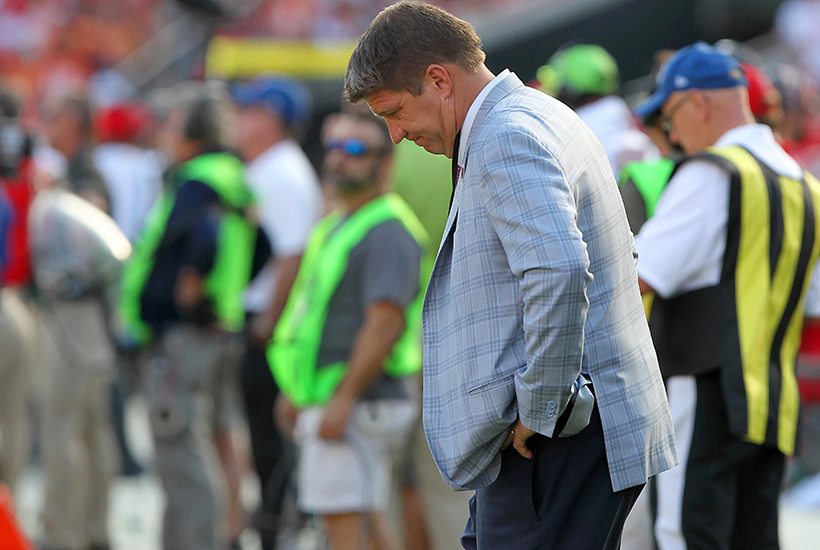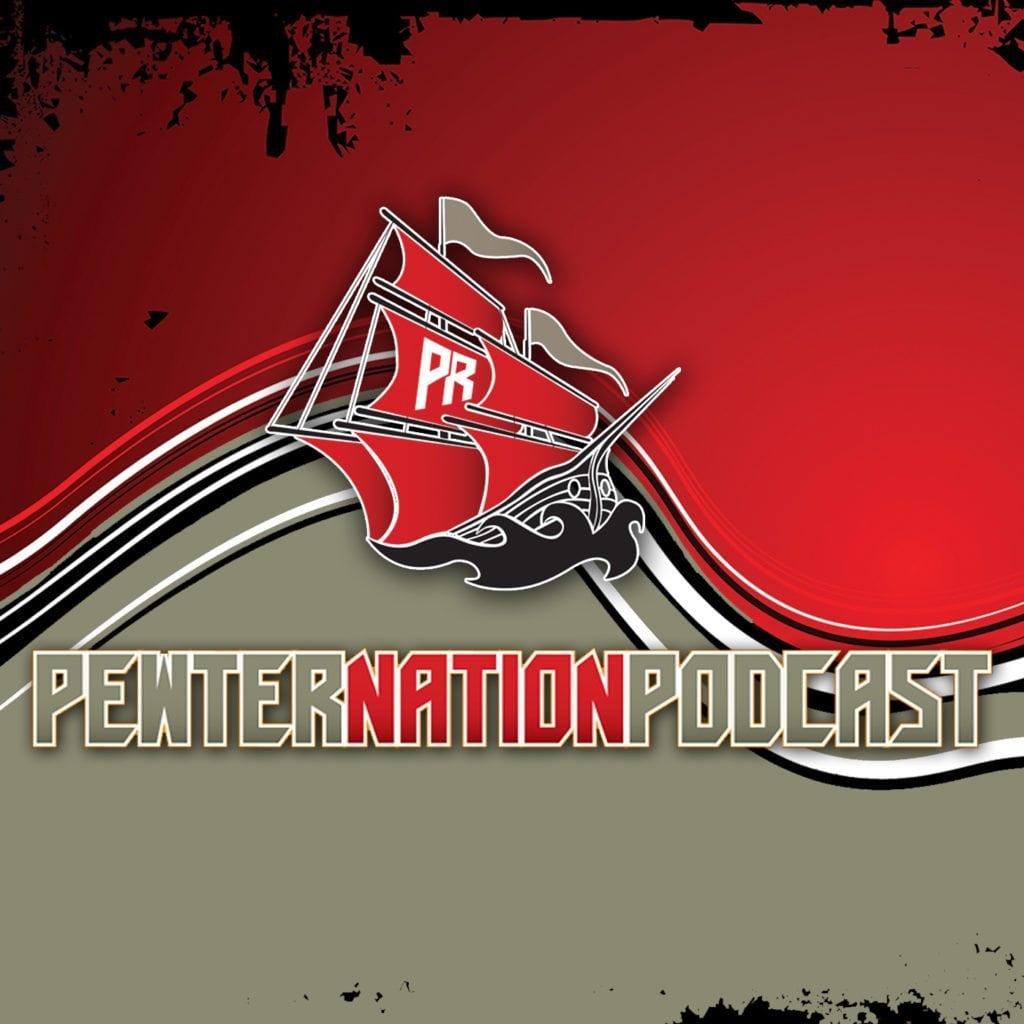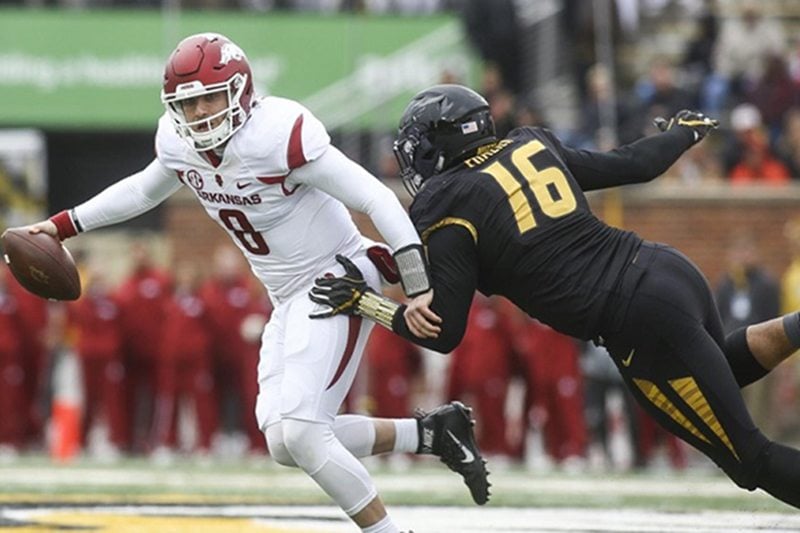FAB 3. Bucs Are Flush With Cap Room, Can Create More
Buccaneers general manager Jason Licht has been cautious in free agency since being burned after the 2014 spending spree that saw the team spend tens of millions of dollars to sign defensive end Michael Johnson, quarterback Josh McCown, left tackle Anthony Collins, cornerback Alterraun Verner, defensive tackle Clinton McDonald and tight end Brandon Myers. The notable free agent signing in 2015 was linebacker Bruce Carter, who quickly lost his job to then-rookie Kwon Alexander.
Licht’s most successful foray into free agency came in 2016 when he signed punter Bryan Anger, cornerback Brent Grimes and defensive end Robert Ayers, Jr. Those players helped the team finish 9-7 and nearly make the playoffs. Last year, Licht spent big money on wide receiver DeSean Jackson, defensive tackle Chris Baker and safeties T.J. Ward and J.J. Wilcox, who was eventually traded to Pittsburgh and replaced with Ward.

Bucs GM Jason Licht – Photo by: Cliff Welch/PR
Although free agency is just as big of a gamble as the draft is – and perhaps even more so – it is necessary, especially for teams like Tampa Bay, which has plenty of holes in the roster and needs to improve from a disappointing 5-11 season. And for Licht and head coach Dirk Koetter, who have been given one more year by the Glazers to get the Bucs back to their winning ways, making the right moves in free agency this year is vital.
If I were in Licht’s seat I would look at this in one of two ways. What’s going to help me keep my job and tick off the Glazers less – spend less and sign fewer free agents so there is less risk of losing money on players like Johnson, Collins, Baker and Ward? Or spend more, knowing that some free agent signings aren’t going to be hits, but also knowing that sticking with the same roster will produce a similar 5-11 result if the Bucs aren’t active in free agency?
I think the Glazers would be more ticked off if Licht didn’t try to radically improve the roster and produce wins, because winning is what matters most. And if I’m Licht I’m going to try to sign every player that I believe could upgrade Tampa Bay’s roster – whether they are a bargain basement find or come with a premium price tag.
So how big of a player could the Bucs be in free agency? According to OverTheCap.com, all NFL teams will have a $178 million salary cap in 2018, and the Bucs currently have $61,476,282 worth of cap room, which ranks as the fifth most in the league.
NFL Teams With The Most Cap Room In 2018
1. 49ers – $114,740,126 – 61 players signed
2. Browns – $110,667,882 – 62 players signed
3. Colts – $82,081,010 – 62 players signed
4. Jets – $74,579,406 – 53 players signed
5. Buccaneers – $61,476,282 – 54 players signed
As noted above, the Bucs currently have 54 players signed to their 90-man offseason roster. That number doesn’t count the team’s players that will be free agents in 2018, such as offensive linemen Kevin Pamphile, Evan Smith, running back Charles Sims, defensive tackle Clinton McDonald or cornerback Brent Grimes, who had an $8 million cap value himself last year, nor does it include the seven draft picks who will arrive in late April.
While it’s way too early to preview free agency because a lot of players will be re-signed by their own teams or given the franchise tag, in addition to some surprise salary cap cuts, here’s how Licht can create additional salary cap room if Tampa Bay plans to be aggressive. All salary cap data and contract data provided by Spotrac.com and OverTheCap.com.

Bucs DT Gerald McCoy – Photo by: Getty Images
Trade DT Gerald McCoy – $12.25 million savings
No, I’m not advocating getting rid of McCoy, but it would be foolish for any general manager not to gauge the trade value of his star players. This happens all the time behind the scenes in NFL front offices. The Seahawks did that last summer with Pro Bowl cornerback Richard Sherman, and it happened to be made public. It is just part of the business. If McCoy, who turns 30 this year, were to be traded for draft picks now would be the time before his value slips on the other side of 30.
McCoy is in the middle of a six-year, $95.2-million contract extension, and it comes at a pivotal moment. McCoy’s base salary decreases from $13.25 million in 2017 to $12.25 million this season, but more importantly, there is just a $500,000 signing bonus proration that would result in dead money to contend with if the Bucs were to trade McCoy. That means that if the Bucs were to trade him, the team would save $12.25 million in cap space in 2018. Tampa Bay was unable to part ways with McCoy in prior years without taking a significant cap penalty, such as $14.25 million in dead money in 2017.
Cut RB Doug Martin – $6.75 million savings
Martin lost any guaranteed money in his latest contract when he tested positive for PED use and was suspended four games. After signing a five-year, $35.75 million contract extension after rushing for over 1,400 yards and earning his second Pro Bowl berth, Martin has been a huge disappointment, rushing for less than 500 yards in each of the last two seasons. Martin is due to make $6.75 million in 2018 and doesn’t deserve it. There is no justification for it. That’s how much money the Bucs will save on their salary cap if they release him – and they should.
Cut or trade DE Will Gholston – $6.5 million savings
Gholston signed a five-year, $27.5 million contract with the Bucs last March that paid him $7 million in 2017 with $4 million coming in the form of a roster bonus and $3 million in base salary. Gholston’s salary rises to $6.5 million next year and becomes guaranteed on March 18, but there is no cap penalty if he is cut by then. After two straight years of three sacks, one forced fumble and at least 49 tackles, Gholston’s numbers plummeted as he failed to record a sack or a takeaway, and finished with just 36 tackles. Yet, he’s only 26 and has performed well in the past as a run stuffer on the strong side. I’m not advocating his release or that he be traded, but his large salary puts him on this list as an obvious candidate.

Bucs DE Robert Ayers, Jr. and DT Chris Baker – Photo by: Cliff Welch/PR
Cut DE Robert Ayers – $6 million savings
Ayers is entering the final year of his three-year, $19 million contract with Tampa Bay. He made $6 million last year and is expected to make $6 million again in 2018 with $5 million coming via base salary and $1 million as a roster bonus. There is no dead cap penalty if the team releases Ayers, who turns 33 in September, before March 18, as that is when he will receive his roster bonus. Ayers had just 31 tackles, two sacks and two forced fumbles last year.
Cut DT Chris Baker – $4.875 million savings
Baker signed a three-year, $15.75 million contract with Tampa Bay in March, which included $6 million in guaranteed money. Baker will have $3 million of his $4.875 million base salary guaranteed if he is on the roster on March 18. The Bucs can save $4.875 million by releasing Baker, who turns 31 in October, without any dead cap penalty if he is released by March 17. Baker was a disappointment in his first year in Tampa Bay with just 33 tackles and half a sack.
Cut G J.R. Sweezy – $4 million savings
Sweezy is in the second year of a reworked four-year deal that is scheduled to play him $21.75 million. He’s set to earn a $5.25 million base salary, which is up from the $3.75 million he made in 2017. That salary, coupled with a $625,000 signing bonus proration, puts his cap hit at $5.875 million. Tampa Bay would suffer a $1.875 million dead cap hit this year if it were to release Sweezy, but there would actually be a cap savings of $4 million as his salary would come off the books. Sweezy had one of his worst years last year as he returned from a back injury that cost him the 2016 season.

Bucs RB Jaquizz Rodgers – Photo by: Getty Images
Cut RB Jacquizz Rodgers – $1.6 million savings
Rodgers is in the second year of a two-year, $3.3 million contract in which he is scheduled to make $1.6 million in base salary. Rodgers, who turns 28 in February, is a decent third-string running back, but the Bucs already have that player in Peyton Barber. Tampa Bay would be better off with a cheaper rookie with more upside and a higher ceiling in 2018.
If the Bucs part ways with Martin, Gholston, Ayers, Baker, Sweezy and Rodgers the team would save $29.725 million and create that much more additional cap room. That would push Tampa Bay’s available cap room to $91,201,282, which would be the third-most in the league. If the Bucs were to cut those players in addition to trading McCoy, the available amount of salary cap room grows to $41.975 million and would give Tampa Bay $103,453,282 worth of salary cap room.
Scott Reynolds is in his 30th year of covering the Tampa Bay Buccaneers as the vice president, publisher and senior Bucs beat writer for PewterReport.com. Author of the popular SR's Fab 5 column on Fridays, Reynolds oversees web development and forges marketing partnerships for PewterReport.com in addition to his editorial duties. A graduate of Kansas State University in 1995, Reynolds spent six years giving back to the community as the defensive coordinator/defensive line coach for his sons' Pop Warner team, the South Pasco Predators. Reynolds can be reached at: [email protected]




